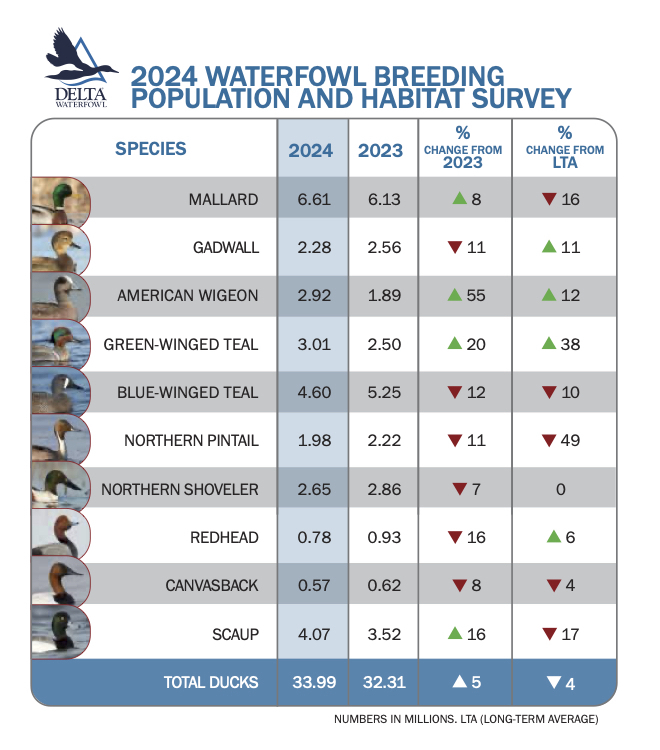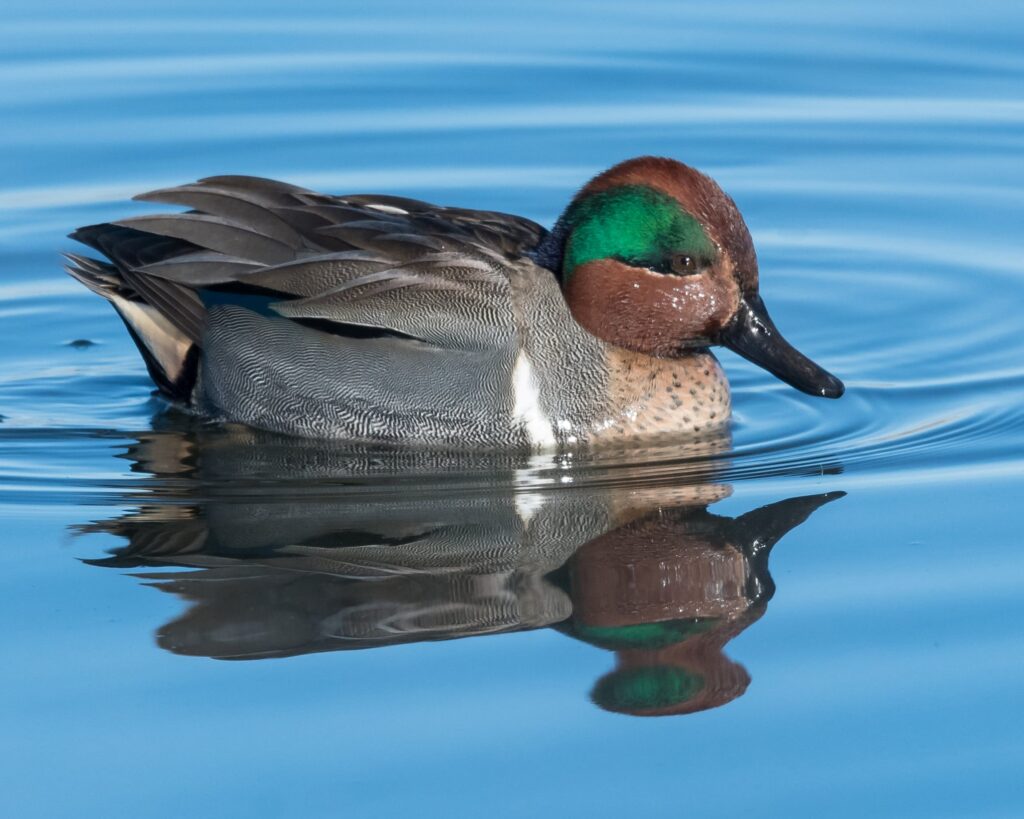Delta Waterfowl Reports: Annual Breeding Waterfowl Population Survey Estimates 33.99 Million Ducks, Up 5% From 2023
 |
Mallards, wigeon, green-winged teal, and scaup post increases; Pintail bag limit for 2025-2026 season will increase to 3 daily in all flyways
Duck numbers are up, and wetland habitat conditions have improved over important portions of the key prairie pothole region.
The breeding population of ducks was estimated at 33.99 million, a 5% increase over last year, according to the 2024 Waterfowl Population Status report released today by the U.S. Fish and Wildlife Service. In addition, May pond counts, a key indicator of breeding habitat conditions and potential production, also increased by 4% over the previous spring.
The report details the results from the Waterfowl Breeding Population and Habitat Survey, which has been conducted annually by the USFWS and Canadian Wildlife Service since 1955. The survey is used to set hunting regulations for the following year, so in this case, for the 2025-2026 season. Based on these results, waterfowl hunters will again enjoy a liberal season framework next season.
“An increased breeding population of ducks and pair counts, along with wetland habitat conditions that improved throughout May and June with good spring rains across most of the prairies, should help boost duck production,” said Dr. Frank Rohwer, president and chief scientist for Delta Waterfowl. “We definitely have potential bright spots for duck production in the eastern Dakotas and possibly in Manitoba. The spring rains really helped in those areas, as well as parts of Alberta that started the spring quite dry.”
The survey, which was completed in May, estimated 5.16 million total ponds, a 4% increase overall. However, the location of those ponds differed greatly from 2023. The ponds estimate on the Canadian prairie and parklands, which includes southern regions of Alberta, Saskatchewan, and Manitoba, decreased 19%. Meanwhile, ponds in the United States, including Montana and the Dakotas, increased by 49%.
“The prairies didn’t have a good snowpack last winter,” said Mike Buxton, waterfowl programs director for Delta Waterfowl. “Heading into last fall, conditions were OK in the Dakotas, but prairie Canada was dry. Manitoba got decent snow, but not so much in Saskatchewan and Alberta. So, the wetland habitat there started spring in poor condition. That really affects where ducks settle. If the table isn’t set early on, ducks don’t stick around to nest. Alberta was really dry, so not many ducks settled there. Saskatchewan was a little bit better.”
While the number of total ducks in the Traditional Survey Area increased slightly over 2023, all of the gains were in the far north and west. Just three survey regions (out of eight) posted increases. The Central and Northern Alberta/Northeast British Columbia/Northwest Territories estimated 11.25 million ducks, up 35% and 49% above the long-term average for the region. The Alaska Yukon Territory/Old Crow Flats region showed a 28% increase over 2023, while Northern Saskatchewan/Northern Manitoba/Western Ontario was up 5%. In contrast, duck estimates across the prairie pothole regions were down 10% to 16%, except for the Eastern Dakotas, which was down less than 1% from 2023.
Among key species, mallards increased 8% to 6.61 million, an estimate that puts them 16% below the long-term average. The far northern and western regions accounted for all of the increase. Mallards decreased in every region of the PPR, including an 8% drop in Southern Saskatchewan, which historically has more breeding mallards than any other region in the survey. The region has experienced below-average water conditions for several years in a row.
Wigeon posted the most dramatic change in this year’s survey, up 55% overall to 2.92 million. As with mallards, most of the increase occurred far northern and western areas, although wigeon were up in the Eastern Dakotas and Southern Saskatchewan, too.
Green-winged teal, an important species for hunters in all four flyways, increased 20% to 3.01 million. Greenwings nest primarily in the boreal forest regions north of the PPR.
Scaup, another boreal forest nesting duck, increased 16% to 4.07 million. Scaup remain 17% below the LTA.
The breeding populations of four key prairie-nesting puddle duck species—gadwalls, blue-winged teal, shovelers, and pintails—dropped this year. Gadwalls declined 11% to 2.28 million but remain 11% above their LTA. Notably, gadwalls increased by 20% in the Eastern Dakotas, but were sharply lower across the southern Canadian prairie provinces. Blue-winged teal dropped 12% to 4.6 million, which is 10% below the LTA. Shovelers were down 7% to 2.65 million.
Pintails declined 11% to 1.98 million, with every region in the PPR posting a decrease. However, pintails were up 39% in the Central and Northern Alberta/Northeast British Columbia/Northwest Territories. The far north and west regions of the survey accounted for more than half of the breeding pintail estimate this year.
Despite a decrease in the pintail breeding population, the USFWS is implementing a new integrated hunter interim harvest strategy that will take effect for the 2025-2026 U.S. hunting season. Based on a 2024 breeding population just shy of 2 million pintails, hunters in all four flyways will be allowed to take three pintails daily in 2025-2026. Please note that the daily bag limit for the upcoming 2024-2025 season remains one pintail in the lower 48 states.
“We’re excited that the new pintail strategy is in place for the 2025-2026 season,” said Dr. Chris Nicolai, waterfowl scientist for Delta Waterfowl. “We’re now managing pintails with a different measure of harvest that incorporates banding data, which made a huge difference in the harvest strategy. The new results suggest we’ve been overestimating pintail harvest by a factor of 2.3 times. The data also has allowed waterfowl managers to learn that especially for mallards and pintails, hunting harvest doesn’t have as much of an impact as we used to think it did, especially at low population sizes.”
Canvasbacks and redheads, a pair of diving duck species, declined this spring. Canvasbacks fell 8% to 566,000, while redheads declined 16% to 782,000. Both species were up in the Eastern Dakotas, but down substantially in Southern Saskatchewan, which is a key breeding region for these large divers.
Habitat conditions were good to excellent across most of the Eastern Survey Area, and breeding duck numbers there are strong. Five of the six species posted in the report’s tables increased, led by a 42% increase in goldeneyes, a 20% jump in green-winged teal, and a 17% rise in black ducks. Ring-necked ducks were up 9%, with mergansers posting a 1% increase. Mallards decreased 4% to 1.17 million but remain above the threshold for a four-mallard daily bag limit for the 2025-2026 season.
As we remind duck hunters every year with the release of the Waterfowl Population Status, we hunt the fall flight, which is made up of not only the breeding population, but also all the new birds from this year’s breeding effort. On that accord, hunters have hope for a better duck season than the survey results indicate.
After a dry start, Buxton noted that wetland conditions improved across the PPR as the nesting season progressed.
“We had perpetual rains throughout late May and June (after the USFWS survey), and that really filled wetlands up and kept them full,” he said. “We were really fortunate to have sustained water in the Eastern Dakotas and Manitoba throughout the majority of the breeding season. We expect to see good production in those places this year. Conditions in Alberta and Saskatchewan improved later in the spring. At a Delta research site in Alberta, we found surprisingly few nests during the first month, but after spring rains arrived, the number of nests improved dramatically.”
Delta Waterfowl continues to help ducks thrive throughout North America, continually expanding the organization’s innovative Habitat Conservation and Duck Production programs.
“We hope the ducks cooperate, and that everyone has an excellent waterfowl hunting season with their families and friends,” Rohwer said.
Delta Waterfowl is The Duck Hunters Organization, a leading conservation group working to produce ducks and ensure the future of duck hunting in North America. Visit deltawaterfowl.org.
For more information, contact Dr. Frank Rohwer at frohwer@deltawaterfowl.org, Dr. Chris Nicolai at cnicolai@deltawaterfowl.org, or Mike Buxton at mbuxton@deltawaterfowl.org.
You may also like
-
DNR Seeking Public Input On Duck Hunting Season Zones And Splits Proposals
-
DNR Seeking Public Input On Duck Hunting Season Zones And Splits Proposals
-
Midwinter Thunderstorm
-
A Better Bitter End Experts chime in on how to make your last waterfowl hunts of the season…your best
-
“The Fowl Life” from Joel Kleefisch, listen to his podcast.
